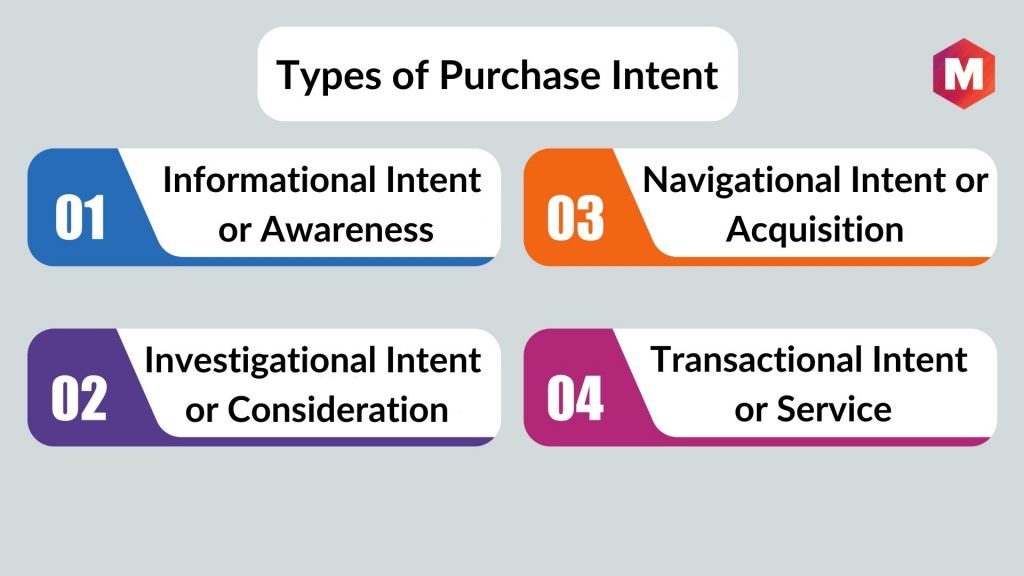Definition: Purchase intent, also known as buying intent is a metric that refers to the likelihood that a customer will make a purchase. It is determined through data collected from direct customer feedback, digital sources, and other analytics. An example of purchase intent is when a user searches for a product or service on the internet and clicks through to visit the website.
By unlocking the mystical power of purchase intent, companies can understand their customer’s desires and buying habits. With this knowledge, firms can craft laser-focused advertising campaigns and marketing messages that drive sales and strengthen customer loyalty.
Quantifying purchase intent is achievable by tracking the number of visitors who complete transactions, analyzing how much time they spend on a checkout page, and noting their return rate when buying from the same place. Additionally, surveys can be distributed to customers asking them what motivated their decision-making process while making purchases.
Table of Contents
What is Purchase Intent?
Purchase intent is the extent to which a customer is willing to buy a product. If you’re actively seeking to gain insight into purchase intent, then Google Analytics is an indispensable tool. This powerful platform can help identify user behaviors, monitor page performance, and track conversions – making it easier than ever to get the insights you need!
The customer has their own ideas or their own previous experience on what they want to purchase. For a seller or a business, buyer intention in a buying process is something that will affect their sales very much. It is very much like a foodie choosing a favorite restaurant over the others because he likes the food there better.
The Business Dictionary gives us the definition of purchase intent in minimal words as “a plan to purchase a particular good or service in the future”. But before a brand can steadily build its marketing efforts on the buying intention of its product, they need to establish itself as a reliable and trustworthy merchant in the market.
Now, the below given examples will help you understand what is purchase intent more practically-
Examples of Purchase Intent
1) Ecommerce Portals
Even E-commerce portals use purchase intentions smartly in their marketing strategies. If you visit the Amazon website now and search for a particular product, then Amazon advertises the same products to you, even when you visit some other website. This is done by retargeting. The essence is – you are a customer with purchase intent, and Amazon wants to show you more and more products so that you purchase from Amazon.
2) Hypermarket Showrooms
Similarly, we have seen a rise in multi-branded and hypermarket showrooms more than in small showrooms. Why is that? and how do these showrooms make a profit? These large showrooms work on the concept of purchase intent. In essence, any customer that enters these showrooms enters with the intent to purchase. Their key objective is that the customer should buy something or the other. This is why they have retail executives in place who will attract customers to a new range of watches or new perfumes to buy. They might even have lines of impulse-buying products so even though the customer has no buyer intent for these products, he buys these products on impulse.
Types of Purchase Intent
There are different types of purchase intent a customer can have, and some of those are –
1. Informational Intent or Awareness
It is when the customer knows that a certain product exists and has information about that product. Buyer awareness occurs when a consumer becomes aware of a problem in their life and actively looks for a solution. At this stage, consumers are gathering information using their awareness as buyers before making a purchase.
2. Investigational Intent or Consideration
It is when the customer starts comparing different products to find the best solution. The buyer will look at various features and benefits of each product before deciding on the best one. They will research different products and brands to decide which one offers the best value for their money.
3. Navigational Intent or Acquisition
It is when the customer has made a final decision on which product to buy and moves towards purchasing it from any specific brand. This includes selecting a store, time, and payment method. They may also look for discounts and coupons to get the best deal.
4. Transactional Intent or Service
For a business, the favorite signal is transactional intent, as it indicates that potential customers are ready to make a purchase. It shows that a customer is looking for service, product support, or answers to their queries from a particular business. This is the stage where customers are ready to purchase a particular brand and just need some additional information to help them in their decision-making.
Role of Purchase Intent in Increasing Sales
It is one favorable factor that can ensure the long life of any business. As long as the customers want to buy your products, irrespective of the availability of similar products in the market, you can stay alive with steady growth.
Things are not yet so simple though. The factors that influence purchase intent are the dependent variables. That is, it can change in your favor or against your business with the slightest of changes in any one of the factors that affect it.
This could be like a chain reaction. The success of your business is closely connected with its purchase intent among potential customers. Measuring purchase intent is determined by a number of factors. Let us now see what factors will affect the purchase intentions for any product, with immediate effect!
Factors Affecting Purchase Intent
A new company in the market, cannot influence the purchase intentions of potential customers who are already looking forward to purchasing a particular brand. For example – I have always been a Macintosh fan and I don’t look forward to Windows laptops anymore. But on the other hand, I love Android phones so in a phone shop, Apple will not influence me because I have no purchase intention to buy the same.
So what are the steps that brands can take to influence the purchase intent data of a product?
1. Build a Social Image
To begin with, you should build a social face for your products with a brand. And the brand should have a unique personality. The products you supply should be original and not available to anyone else. The whole process of building a brand face requires planning and implementation of strategies that will counteract the competition.
Marketing campaigns are a huge part of building up a trusted brand. So is the Brand Identity building? Logo, brand mark, design, taglines, brand ambassadors, and collaborations with already established brands are methods to build up a media face. People should have an emotional bond with the brand. This will bring in loyal customers for you. Without such an attachment, you could lose your customers to competitors.
2. Build Trust in the brand
Another determinant of high purchase intent data is trust. This is closely related to the brand itself. The customers should have complete trust in your brand. Time is a major factor that will build trust. If your brand has been in the market for a long time now, chances are you have a greater number of faithful customers.
This is because your business has had time to evolve with the market requirements and grow accordingly. If you look at the most successful brands out there, such as Puma, Nike, or Allen Solly, you will see that they have been here for a very long time now. The customers probably were introduced to these products by their parents or even grandparents. This can build up a strong trust factor.
3. Build word-of-mouth
Talking of parents and grandparents, a recommendation is another factor that can affect your product’s growth for better or for worse. The potential customer always tends to ask for opinions or suggestions before they buy anything of value.
If they are given positive reviews by your customers, you have a chance to stay in the market further. The negative comments can put off those who have not purchased with you yet. This will drive anyway your buyers, which will indeed be a bad thing for business.
4. Quality
To ensure you get positive reviews every single time, the one thing you should supply is quality. Hence, the quality of your products is one of the most powerful factors affecting customer purchase intention.
It is the most important factor because no matter how many recommendations or endorsements your products may receive, a customer who has experienced receiving low-quality products from you once, will not give you another chance. Compromising on the quality you supply or going back to the quality after you have gained a steady customer base are some things that will lead to bad business.
5. Price
Over time, after you have established a place for yourself in your niche and among the competitors, you may increase the price value of the products. This will not affect the purchase intentions of the brand very much. But it could lose you customers who will no longer be able to afford the increased prices. Thus, although price value is a factor that can affect purchase intentions, it does not make such a huge impact on any change in quality will cause.
6. Feedback
To maintain the high purchase intent of your products among customers, you should invite in more reviews. Taking feedback will make the customers feel involved in your brand. This will bring in emotional investments from customers, which is a positive factor for you. Additionally, the packaging of your products can make a change.
The seemingly unimportant things like a shopping bag with your logo or brand mark, multiple tags with brand marks, friendly messages, or even information about how and where the products were created will make an immense difference. These are steps that will make the customers perceive your brand as more of a human one than just a name.
With these factors in mind, you must conduct Severus to know how your brand is performing. Analysis of the kind will let you know about the brand’s purchase intentions. You can then make such changes as will render your brand more popular and successful in the market.
Scientific Background Behind Buying Intent
When it comes to understanding buyer intent, scientists have been studying how humans make purchase decisions for decades. It’s a complex process that involves both psychological and physiological factors. By understanding these influencing factors, you can better target purchase intent in your marketing strategies. Studies have revealed that purchase intent is mostly driven by a person’s needs, emotions, and values.
The attitude-behavior hypothesis in science suggests that attitudes dictate how we act. To ascertain if consumers intend to make purchases, research is often employed as an indicator for predicting behavior. Consequently, our expressed intentions can be used to infer the likelihood of future actions.
Attitude measurement research confirms that consumers’ purchase decisions are mostly the results of a step-by-step process and are more likely to be converted into buying behavior than predispositions. Interviews are also a great way to measure purchasing likelihood. By asking consumers if they intend to buy a particular product, we can get an idea of their purchasing habits and tendencies- even though purchase situations may be unpredictable or ever-changing.
How to Measure Customer Purchase Intent
Determining purchase intent can be immensely insightful for any business, as it indicates their loyalty and readiness to commit. This metric should be tracked diligently using various methods like analyzing the consumer’s shopping history or observing their behaviors. You may use the following methods to measure purchase intent effectively-
1. Brand tracking surveys
Brand tracking surveys are the ideal tool to calculate purchase intent, due to their capacity to monitor and assess multiple aspects of your brand’s health. These include recognition of your brand, usage as well as consumption habits regarding it, reputation in comparison with similar brands on the market today – plus image and feelings associated with it.
2. Product testing surveys
Product surveys are an effective way to gather feedback and insights from customers about customer behavior and their buying decisions. For instance, certain furniture firms have started a trial program that enables clients to test the furniture at home for a few weeks or months. This new system has proven successful in helping companies understand customer preferences while also ensuring they make quality purchases.
3. Customer satisfaction surveys
Don’t forget the loyalty aspect of your marketing funnel! Existing customers who are loyal to your company often spend more than new customers, so you must understand their purchasing intent. A great place to start is by running customer satisfaction surveys and gathering feedback from them. This will give you valuable insights into what direction you should take your business to grow and succeed.
4. Ad testing surveys
With advertising costs continuing to climb, you must understand the effectiveness of your investments. That’s why ad testing surveys are so invaluable for brands to measure purchase intention. They allow you to track how well each advertisement resonates with customers and whether or not its message can truly promote purchase intent. By collecting this data, you will have peace of mind in knowing your money is being spent wisely and that maximum value is achieved from every campaign. It will help you in analyzing purchase intent of your target audience.
Purchase Intent Survey Questions
To leverage purchase intent of your target audience, you can use the following questions –
1. Likert scale survey questions
On a scale of 1-5, how enthusiastic are you about buying X product or service?
2. Open-ended survey questions
Kindly elaborate on why you selected the rating for the purchase intent query above.
3. Multiple choice survey questions
Are you actively seeking to purchase X products or services?
A) Yes
B) No
C) Maybe/I’m considering it
4. Multi-select survey questions
Which of the following factors is influencing your purchase decision?
A) Price
B) Quality
C) Brand Reputation
D) Availability of product/service
E) Other (Please elaborate)
Conclusion!
To fully grasp the concept of what is purchase intent, consider these salient points –
- As customers traverse the road from recognition of a product/brand to ultimately making their purchase decision, they are undergoing an essential process known as “purchase intent”.
- Uncovering customer insights can be attained by administering surveys and deciphering the customer journey to better understand their actions.
- An array of variables such as digital advertising, content marketing, brand recognition, purchase triggers, and the buying process can significantly affect a customer’s purchase intent.
- By leveraging purchase intent, you can create highly-targeted campaigns and optimize your conversion rate. This approach will not only raise awareness of your products or services but also increase the likelihood that customers take action and convert.
Companies that understand purchase intent can create more effective strategies to drive sales and customer loyalty. This knowledge allows them to craft engaging, personalized experiences which result in repeat customers and long-term success. Harnessing purchase intent is a powerful way for brands to gain an edge over their competition.
Liked this post? Check out the complete series on Marketing


